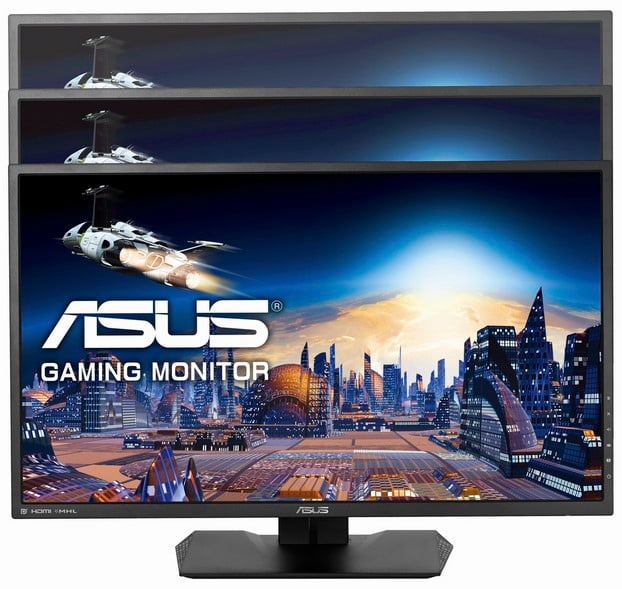ASUS MG279Q 144Hz IPS FreeSync Monitor Review
Inspecting The ASUS MG279Q
The ASUS MG279Q is one heck of a good looking display. It has many noteworthy, and actually useful features, and aesthetically we think ASUS has done a good job as well.
One of the most appealing aspects of the ASUS MG279Q are its relatively thin bezels. They are not the thinnest we have seen, but at roughly 1/2” all around and 7/8” at the bottom, they are definitely unobtrusive and make this monitor a good candidate for an Eyefinity or NVIDIA Surround setup. With the exception of a simple ASUS logo centered at the bottom, and some lightly silk-screened labels on the lower-left corner, there are no unsightly features to detract from the display’s good looks.
The rear of the ASUS MG279Q also some interesting design cues. The angular enclosure is fairly clean and has a matte black, textured finish, which looks sleek. At either side of the rear panel, there are long vents that help keep the display’s internals cool. The vertical portion of the stand also has a removable clip, which makes for some easy cable management. Unlike monitors with external power bricks, the ASUS MG279Q has an internal PSU, however, so the overall thickness of the display is a little beefier than some other options.
ASUS didn’t skimp on the MG279Q‘s stand either—it supports height, swivel, tilt, and pivot adjustments. The ROG Swift PG278Q’s height is adjustable from 0 – 120mm, the display swivels 60 degrees to either side, it can tilt from +20 to -5 degrees, and it can pivot from portrait to landscape mode.
Silkscreened on the right side of the base in red lettering is the message “Supreme Gaming Experience”, and the base also features the same angular design language as the ROG SWIFT, but the base does not have any built-in lighting. We should also mention that the base isn’t very heavy, though it is nice and wide and quite sturdy. There’s no way you’re knocking this display over without putting some serious force behind it. The base does need to be assembled, however, but it’s only a matter of snapping the vertical assembly into the back of the display and tightening a single thumbscrew on the base itself.
In terms of connectivity, the MG279Q has all of its bases covered. The display is equipped with a pair of HDMI inputs (MHL compatible), a full sized DisplayPort input, and a mini-DP input (a mini-DP to full sized DP cable is included). There’s also a standard power connector and three USB 3.0 ports—one upstream and two downstream.
Note that to take advantage of the high refresh rate at this display’s native resolution, or to use Adaptive Sync / FreeSync, you will have to use a DisplayPort input. The HDMI inputs can run at 1920x1080 120Hz, but for 2560x1440 144Hz operation, the bandwidth of DisplayPort is required.
One of the most appealing aspects of the ASUS MG279Q are its relatively thin bezels. They are not the thinnest we have seen, but at roughly 1/2” all around and 7/8” at the bottom, they are definitely unobtrusive and make this monitor a good candidate for an Eyefinity or NVIDIA Surround setup. With the exception of a simple ASUS logo centered at the bottom, and some lightly silk-screened labels on the lower-left corner, there are no unsightly features to detract from the display’s good looks.
The rear of the ASUS MG279Q also some interesting design cues. The angular enclosure is fairly clean and has a matte black, textured finish, which looks sleek. At either side of the rear panel, there are long vents that help keep the display’s internals cool. The vertical portion of the stand also has a removable clip, which makes for some easy cable management. Unlike monitors with external power bricks, the ASUS MG279Q has an internal PSU, however, so the overall thickness of the display is a little beefier than some other options.
ASUS didn’t skimp on the MG279Q‘s stand either—it supports height, swivel, tilt, and pivot adjustments. The ROG Swift PG278Q’s height is adjustable from 0 – 120mm, the display swivels 60 degrees to either side, it can tilt from +20 to -5 degrees, and it can pivot from portrait to landscape mode.
Silkscreened on the right side of the base in red lettering is the message “Supreme Gaming Experience”, and the base also features the same angular design language as the ROG SWIFT, but the base does not have any built-in lighting. We should also mention that the base isn’t very heavy, though it is nice and wide and quite sturdy. There’s no way you’re knocking this display over without putting some serious force behind it. The base does need to be assembled, however, but it’s only a matter of snapping the vertical assembly into the back of the display and tightening a single thumbscrew on the base itself.
In terms of connectivity, the MG279Q has all of its bases covered. The display is equipped with a pair of HDMI inputs (MHL compatible), a full sized DisplayPort input, and a mini-DP input (a mini-DP to full sized DP cable is included). There’s also a standard power connector and three USB 3.0 ports—one upstream and two downstream.
Note that to take advantage of the high refresh rate at this display’s native resolution, or to use Adaptive Sync / FreeSync, you will have to use a DisplayPort input. The HDMI inputs can run at 1920x1080 120Hz, but for 2560x1440 144Hz operation, the bandwidth of DisplayPort is required.












